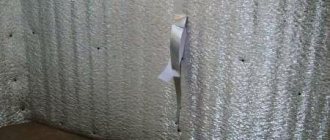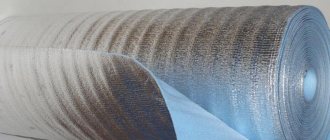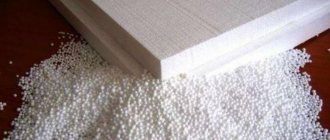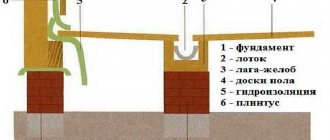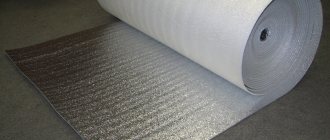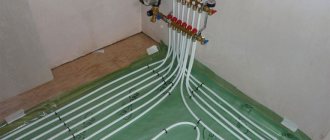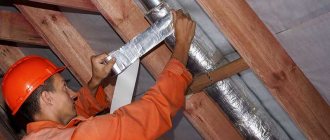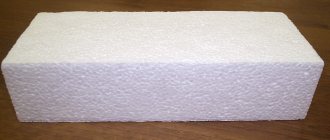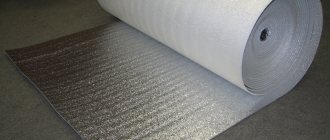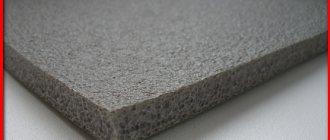Foamed polyethylene in construction is used as a substrate for floating floors or under laminate. It is used for thermal insulation of water and sewer pipes, and is also used in other works as an auxiliary material. Polyethylene foam is an effective technical insulation, which is usually sold in rolls and has a dark gray color. In some cases it can be dyed, for example for trims, to give the sheets the desired color.
We wrote about the effectiveness of polyethylene foam as pipe insulation in our article on the need to insulate pipelines in a private home.
Foamed polyethylene what is it?
PPE is a gas-filled thermoplastic substance derived from polyethylene. It has a closed porous structure and is used as an insulator against noise, moisture and heat. Such a heat insulator appeared on the market more than 50 years ago, and since then it has been used in various fields of activity. Let's pay attention to its key technical characteristics:
- retains its durability and elasticity even at the lowest temperatures (down to -60 degrees);
- the material has flammable properties; therefore, its operating temperature should not exceed +100 degrees. At extremely high temperatures, polyethylene foam begins to melt and ignite;
- environmentally friendly and reliable insulation. Its service life can reach five years, subject to proper use;
- easy to install, has a relatively small thickness.
Features of penofol fastening
Penofol (isolon) is produced by special foaming of polyethylene. The insulation is covered with aluminum foil, which maximizes heat retention. It is used for internal and external work, in finishing production mechanisms, preserving heat in pipelines or air conditioning systems. It comes in rolls and individual plates. It may have additional characteristics – thickness, color. The bonding of foil to the plane of foamed polyethylene can be chemical or physical (cross-linked).
- small thickness;
- environmentally friendly;
- does not require additional skin and respiratory protection;
- there is no need for special tools;
- ease of fastening.
Glue is used for penofol with foil on one side.
Double-sided insulation is used for thermal insulation of loggias, garages, and pipes. They are attached to the sheathing or purchased polyethylene foam with a self-adhesive surface.
How to glue foamed polyethylene?
Almost every person who encounters insulation for the first time wonders how to glue foamed polyethylene so that it sticks firmly and adheres well to the surface. A number of different types of adhesives for PPE are offered in stores or markets, however, you need to know a few nuances that will help you make the right purchase:
- the temperature range must correspond to the characteristics of the insulation;
- adhesive properties should be as high as possible;
- for interior finishing work, you should choose non-toxic and high-quality glue;
- for exterior finishing, you should buy a moisture-resistant product that can withstand high temperatures and difficult weather conditions;
- in the case of finishing a bathhouse or sauna, swimming pools, it is necessary to mix the glue with moisture-repellent agents.
For gluing all types of flexible thermal insulation Armaflex, the adhesive composition Armaflex 520 is used. This is a highly adhesive solution based on polychloroprene. Used for insulation designed for temperature exposure from -50 to +105°C. Thermaflex ThermaEco adhesive and K-Flex K 467 contact adhesive are also used for thermal insulation made of polyethylene foam.
To work with PPE, water-based products should absolutely not be used, since its structure does not allow the adhesive substance to penetrate into all the pores of the material.
Gluing with acrylate glue with filler
The best glue is Weicon Easy-Mix PE-PP. It is specially designed for materials with weak adhesion. Most liquids “stick” to polyethylene very poorly and are simply squeezed out from the point of contact between the surfaces.
Appearance of Weicon Easy-Mix PE-PP glue
But this glue contains the addition of tiny glass beads, which prevents the glue from leaving the gluing area, forming a gap of the required thickness. Therefore, the gluing surface is sufficient and the glue, when hardened, holds the surfaces firmly together. It’s hard to find anything better than gluing polyethylene.
Surfaces must be thoroughly degreased and dried before gluing. Glue can only be supplied from a branded packaging mixer. The best temperature for doing work is +21. +23 °C. Liquid glue is good for no more than 2-3 minutes. After applying the layer, you must immediately join the surfaces. Full readiness of the seam (maximum mechanical strength) for polyethylene will be achieved in a few hours (4-5 according to the experience of those who worked with glue). The curing of the adhesive joint is carried out at a temperature from +15 to +70 degrees.
Table: Properties of adhesives for polyethylene
| Name | Thermaflex TermaEco | Armaflex 520 glue | Contact glue K-Flex K 467 |
| Brand | Thermaflex | Armaflex | K-Flex |
| Material | neoprene based | on a polychloroprene basis, without aromatic solvents | on polychloroprene rubber |
| Application temperature | from -40 to +105 ºС | from -50ºС to +105 ºС | from -40 to +105 ºС |
| Consumption | for pipe insulation with a thickness of 6 mm – 1 liter per 150 linear meters. m; 9 mm – 1 l per 120 linear. m; 13 mm – 1 l per 100 linear. m; 20 mm – 1 l per 70 linear. m; 25 mm – 1 l per 50 linear. m; for flat surfaces and rectangular air ducts – 1 liter per 10 linear meters. m; for pipes with a diameter of more than 114 mm - 1 liter per 6 linear meters. m | Minimum adhesive consumption, applied to both surfaces: Armaflex tubes (thickness > consumption for gluing tube seams without a cut > consumption for gluing tube seams with a cut): 10 mm > 1120 m/l > 140 m/l 20 mm > 280 m/l > 70 m/l30 mm > 175 m/l > 45 m/l40 mm > 130 m/l > 35 m/l | for pipe insulation with a thickness of 9 mm – 1350 linear meters; 13 mm – 500 linear m; 19 mm – 300 linear m; 25 mm – 220 linear m; for flat surfaces and 6–8 sq.m.; |
| Package | jar 0.5 l; 1 l and 3 l | can 0.25 l; 0.5 l; 1 l and 2.5 l | 2.6 l can |
How to glue foamed polyethylene to concrete?
In order to properly glue the sheets to the concrete surface, it must be thoroughly cleaned. Remove all irregularities and defects, and lubricate protruding metal objects with an anti-corrosion compound. To achieve maximum adhesion, after cleaning the concrete surface is primed.
Adhesive for PPE must have the following characteristics:
- high level of moisture resistance;
- must not damage (corrode, distort) the surface;
- resistant to adverse conditions;
- preservation of adhesive properties for a long time.
In order for polyethylene foam to adhere well to concrete, one of the important components of the adhesive must be a solvent, since a specific composition has been developed for each material. For finishing rooms with high humidity, heat-resistant glue is used. All adhesives used for interior work must have quality certificates.
How to paint foamed polyethylene?
Let's start with what you shouldn't paint it with. Many people try to cover it with acrylic or regular construction paint. However, practice has shown that acrylic is not a suitable option for coating. Acrylic quickly crumbles from the surface, leaving unsightly places here and there.
PPE should be coated with alkyd paints from cans, or with alkyd enamel. Thus, the layer you applied will not peel off, gradually losing its original appearance.
There are a number of products available for painting polyethylene foam that demonstrate excellent performance properties. Thermaflex company offers a large selection of accessories for installation, among which it is worth noting Vioterm Finish paint. The water-based composition perfectly covers the thermal insulation and protects it. In addition, the solution is available in several colors.
Table: Properties of paints for polyethylene foam
| Name | Vioterm Finish paint | K-Flex K-Finish paint | Armafinish 99 paint |
| Brand | Thermaflex | K-Flex | Armaflex |
| Material | water based | aqueous solution of acrylates | water-based with special additives |
| Consumption | 0.40 l/m² when applied in 2-3 layers (corresponds to a dry film thickness of 0.25-0.30 mm) | 0.45-0.5 l/m2 in two layers | 0.55 l/m² for two layers |
| Package | bucket 2.5 l | 2.5 l can | 2.5 l can |
| Color | white, blue, red, green, yellow, light grey, black | white, gray, black, green, red, blue, sand, pink. | grey, white |
What is foamed polyethylene made from?
PPE is obtained by casting and pressing a foam mass from various ethylene polymers. Basically, it consists of low-density polyethylene with additives that improve its properties. Depends on the technology of its production, as well as on what substances are used in its manufacture. The resulting material can differ significantly in both properties and structure, while maintaining the characteristics of the original substance:
- water resistance;
- non-toxic;
- chemical inertness;
- plastic;
- melting at a temperature of 1000º C;
- resistance to temperature changes.
All these properties are important for all thermal insulation of polyethylene foam pipes. The glue must securely fix the insulation to the base and to each other so that the system circuit is closed and performs its functions 100%.
Types of foil insulation
Foil insulation does not emit hazardous and toxic substances, unlike conventional mineral wool.
There are four types of such insulation; they differ from each other both in appearance and in their area of application and functional features.
- Foamed polyethylene coated with aluminum is used to insulate building walls and ventilation systems. Usually sold in roll form.
- Foiled polystyrene foam is used for floor insulation. It is produced in the form of thick steel-colored sheets.
- Mineral wool with a layer of foil is used mainly for insulating roofs, chimneys and baths. Sold in rolls.
- Basalt foil-coated thermal insulation material is used in all areas of construction, including the construction of gas stations. It has increased resistance to aggressive environments. Withstands temperatures from -200°C to +700°C.
How can you glue foamed polyethylene?
An adhesive that could properly glue this material must have moisture-repellent and high adhesive properties. Foamed polyethylene insulation is often used to insulate walls, pipes and even balconies of residential apartments. And, if you have planned a large amount of work, you need to choose an adhesive mixture in a 25 kg package.
For external parts and structures - mounting or so-called “liquid nails”. Let us remind you that the use of certified adhesives guarantees a successful outcome of the work. Contact adhesive K-Flex K 467 is an excellent one-component composition of the famous K-Flex brand with high adhesion. Using the solution, you can glue polyethylene foam together or glue insulation to copper pipes, metal and other surfaces. To use this glue, you do not need any special knowledge or tools. Don't be afraid to experiment when decorating your home!
Still have questions about the selection of materials, paints and adhesives? Dial +7 (495) 150-05-73. Our managers will help you decide on the brand of materials, calculate their quantity and order them for delivery to your site!
Types of glue
We list the currently most commonly used glue options.
- For rooms with high humidity, MV-40 is suitable, which has moisture-resistant properties. You can also choose T-Avangard-K.
- For residential premises, “Express” or “Universal” are usually used.
- If we are talking about installing external building structures, then it is best to choose liquid nails or assembly adhesive. For example, Moment Montage would be suitable.
- Titanium is good for reinforced concrete base.
- Neoprene-2136 in the form of a spray or Acrol contact type are selected for gluing to penoplex.
- Olfix and Ceresit are universal glue options. They are perfect for working with any type of surface, including concrete.
- Atlas Stopter K-2 kley is selected if you plan to glue the insulation to a mineral base.
- Weicon Easy Mix PE-PP-45 is selected for gluing polypropylene to polyethylene.
After the work, the seams will need to be treated using Tilit or adhesive tape specially designed for this.
The choice of adhesive is largely determined by the purpose of the room that you plan to insulate, whether you will attach it to wood, metal, concrete, etc. It can be difficult to choose on your own without much experience in construction and installation work. Therefore, it is always advisable to consult with specialists.
In the Remonstr store you will find a huge variety of glue options. If you find it difficult to choose, contact our consultants for help, who will promptly respond to your request, help with placing an order, and clarify all the important details regarding payment and delivery.
